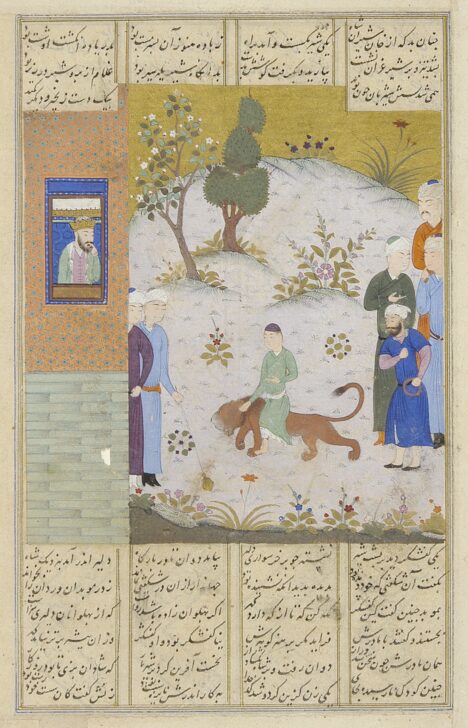The Young Shoemaker and the Lion Before Bahram Gur, from the Shahnama of Firdausi
Iranian

Description
Of all the paintings in the Ann Arbor Shahnama, this is the only one to have a commoner as its protagonist and the only one that is outright comic.
. . . And thus it chanced:
A lion of the Shah’s had broken loose,
And came along the road. Now at the time
The shoemaker was still in drink—a sea
That made his fingers thumbs. He ran, bestrode
The roaring lion, and then reaching out
He clutched its ears. The lion had been fed;
The youth maintained his seat. Post-haste the keeper
Came running after them, a chain in one hand,
A lasso in the other.
Warner, VII, 24
The shoemaker is recognizable by his simple cap and bare feet, in contrast to the turbaned and booted nobles who line the approach to the palace. Bahram Gur watches the scene from his window, a finger to his lip revealing his amazement.
———
Maribeth Graybill, Senior Curator of Asian Art
Exhibited in "A Medieval Masterpiece from Baghdad: the Ann Arbor Shahnama"
August 14 through December 19, 2004
Subject Matter:
The Young Shoemaker and the Lion Before Bahram Gur
...And thus it chanced:
A lion of the Shah's had broken loose,
And came along the road. Now at the time
The shoemaker was still in drink--a sea
That made his fingers thumbs. He ran, best rode
The roaring lion, and then reaching out
He clutched its ears. The lion had been fed;
The youth maintained his seat. Post-haste the keeper
Came running after them, a chain in one hand,
A lasso in the other.
Physical Description:
This Persian miniature is attributed to the Shiraz and Timurid schools, ca. 1460. The painting is done in ink, opaque watercolor and gold leaf on paper. The scene, The Young Shoemaker and the Lion Before Bahram Gur, is part of the Shahnama of Firdausi, the Persian book of kings.
Usage Rights:
If you are interested in using an image for a publication, please visit https://umma.umich.edu/request-image/ for more information and to fill out the online Image Rights and Reproductions Request Form.